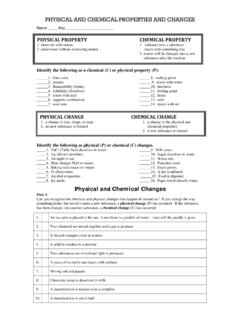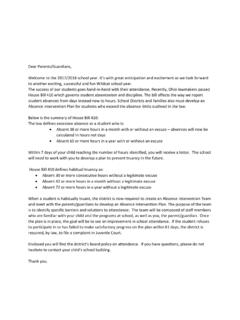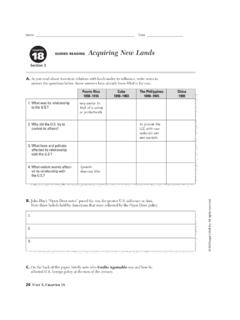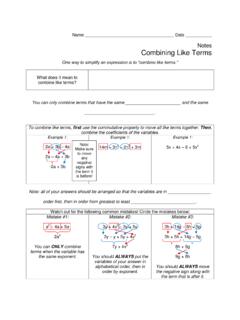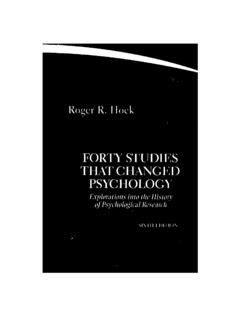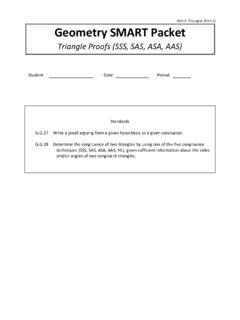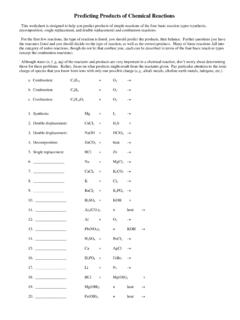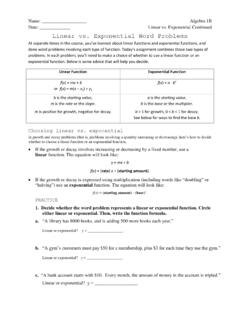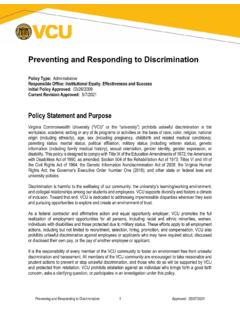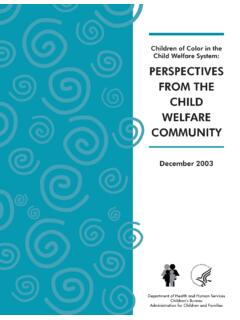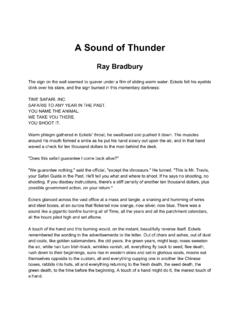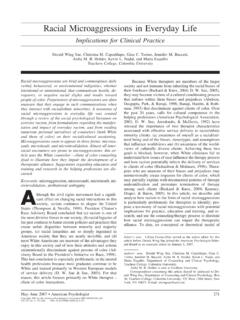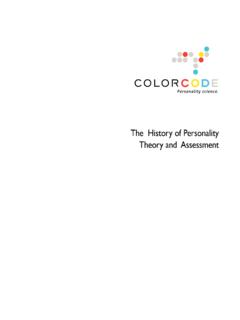Transcription of UNIT 4: SENSATION AND PERCEPTION
1 BASIC PRINCIPLES OF SENSATION AND PERCEPTION OBJECTIVE 1: Contrast SENSATION and PERCEPTION , and explain the difference between bottom-up and top-down processing. 1. The perceptual disorder in which a person has lost the ability to recognize familiar faces is ____PROSOPAGNOSIA_____. 2. The process by which we detect physical energy from the environment and encode it as neural signals is ____SENSATION_____. The process by which sensations are organized and interpreted is ____PERCEPTION____. 3. Sensory analysis, which starts at entry level and works up, is called _____BOTTOM_____ - _____UP_____ _____PROCESSING_____. Perceptual analysis, which works from our experience and expectations is called ____TOP_____ - ___DOWN_____ ___PROCESSING____. OBJECTIVE 2: Discuss how our perceptions are directed and limited by selective attention, noting how we may or may not be affected by unattended stimuli. 4. When we focus our conscious awareness on a particular stimulus, we are using ___SELECTIVE_____ ___ATTENTION_____.
2 5. Your ability to attend to only one voice among many is called the ____COCKTAIL____ ____PARTY_____ ____EFFECT____. Failing to see a visible object when our attention is directed elsewhere is called ___INATTENTIONAL_____ ___BLINDNESS____. 6. When researchers distracted participants with a counting task, the participants displayed __INATTENTIONAL____ ____BLINDNESS____ and failed to notice a gorilla-suited assistant who passed through. Two specific forms of this phenomenon are __CHANGE_____ __BLINDNESS_____ and ___CHOICE_____ ____BLINDNESS_____. Another result of distraction involves not noticing that different people are speaking, called ____CHANGE____ ____DEAFNESS____. 7. Some stimuli are so powerful they demand our attention, causing us to experience ____POP_____ - ___OUT_____. OBJECTIVE 3: Distinguish between absolute and difference thresholds, and discuss whether we can sense and be affected by subliminal or unchanging stimuli. 8. The study of relationships between the physical characteristics of stimuli and our psychological experience of them is ____PSYCHOPHYSICS___.
3 9. The __ABSOLUTE_____ ___THRESHOLD____ refers to the minimum stimulation necessary for a stimulus to be detected ____50_____ percent of the time. 10. According to ___SIGNAL_____ ___DETECTION___ theory, a person s experience, expectations, motivation, and alertness all influence the detection of a stimulus. 11. Some entrepreneurs claim that exposure to below threshold, or ___SUBLIMINAL____, stimuli can be persuasive, but their claims are probably unwarranted. 12. Some weak stimuli may trigger in our sensory receptors a response that is processed by the brain, even though the response doesn t cross the threshold into ___CONSCIOUS___ awareness. 13. Under certain conditions, an invisible image or word can __PRIME____ into a person s response to a later question. This illustrates that much of our information processing occurs ___AUTOMATICALLY___. 14. The minimum difference required to distinguish two stimuli 50 percent of the time is called the ___DIFFERENCE_____ ___THRESHOLD___.
4 Another term for this value is the ___JUST____ ____NOTICEABLE_____ ___DIFFERENCE (JND)___. 15. The principle that the difference threshold is not a constant amount, but a constant proportion, is known as ____WEBER S_____ ___LAW_____. The proportion depends on the ___STIMULUS____. 16. After constant exposure to an unchanging stimulus, the receptor cells of our senses begin to fire less vigorously; this phenomenon is called ___SENSORY____ ___ADAPTATION_____. VISION OBJECTIVE 4: Describe the characteristics of visible light, and explain the process by which the eye converts light energy into neural messages. 1. Stimulus energy is ___TRANSDUCED_____ (transformed) into ____NEURAL_____ messages by our eyes. 2. The visible spectrum of light is a small portion of the larger spectrum of ___ELECTROMAGNETIC___ energy. 3. The distance from one light wave peak to the next is called ___WAVELENGTH____. This value determines the wave s color , or ____HUE_____. 4. The amount of energy in light waves, or ___INTENSITY____, is determined by a wave s ___AMPLITUDE____, or height, influences the ___BRIGHTNESS____ of a light.
5 5. Light enters the eye through the __ CORNEA _____, then passes through a small opening called the ___PUPIL_____; the size of this opening is controlled by the colored ____IRIS_____. 6. By changing its curvature, the ___LENS_____ can focus the image of an object onto the ____RETINA_____, the light-sensitive inner surface of the eye. 7. The process by which the lens changes shape to focus images is called ___ACCOMMODATION___. 8. The retina s receptor cells are the ____RODS_____ and ____CONES_____. UNIT 4: SENSATION AND PERCEPTION 9. The neural signals produced in the rods and cones activate the neighboring ___BIPOLAR_____ cells, which then activate a network of ___GANGLION_____ cells. The axons of ganglion cells converge to form the ____OPTIC_____ ____NERVE___, which carries the visual information to the ___BRAIN_____. 10. Where this nerve leaves the eye, there are no receptors; thus, the area is called the ____BLIND_____ ____SPOT____. 11. Most cones are clustered around the retina s point of central focus, called the _____FOVEA_____, whereas the rods are concentrated in more ____PERIPHERAL_____ regions of the retina.
6 Many cones have their own ___BIPOLAR_____ cells to communicate with the visual cortex. 12. It is the ____CONES_____ (rods/cones) of the eye that permit the PERCEPTION of color , whereas ____RODS_____ (rods/cones) enable black-and-white vision. 13. Unlike cones, in dim light rods are ____SENSITIVE_____ (sensitive/insensitive). Adapting to a darkened room will take the retina approximately ____20_____ minutes. OBJECTIVE 5: Discuss the different levels of processing that occur as information travels from the retina to the brain s cortex. 14. Visual information percolates through progressively more ____ABSTRACT_____ levels. In the brain, it is routed by the ___THALAMUS____ to the cortex. Hubel and Wiesel discovered that certain neurons in the occipital lobe s ___VISUAL_____ ____CORTEX____ respond only to specific features of what is viewed. They call these neurons ___FEATURE_____ ____DETECTORS____. 15. Feature detectors pass their information to higher-level cells in the brain, which respond to specific visual scenes.
7 Research has shown that in monkey brains such cells specialize in responding to a specific ____GAZE_____, ____HEAD_____ _____ANGLE____, ____POSTURE_____, or ____BODY_____ ____MOVEMENT_____. In many cortical areas, teams of cells (____SUPERCELL_____ ____CLUSTERS_____) respond to complex patterns. OBJECTIVE 6: Define parallel processing, and discuss its role in visual information processing. 16. The brain achieves its remarkable speed in visual PERCEPTION by processing several subdivisions of a stimulus _____ (simultaneously/sequentially). This procedure, called _____ _____, may explain why people who have suffered a stroke may lose just one aspect of vision. 17. Other brain-damaged people may demonstrate ____BLINDSIGHT_____ by responding to a stimulus that is not consciously perceived. OBJECTIVE 7: Explain how the Young-Helmholtz and opponent-process theories help us understand color vision. 18. An object appears to be red in color because it ___REFLECTS (REJECTS)_____ the long wavelengths of red and because our mental _____CONSTRUCTION____ of the color .
8 19. One out of every 50 people is color deficient; this is usually a male because the defect is genetically _____SEX_____ - ___LINKED___. 20. According to the ____YOUNG_____ - ___HELMHOLTZ_____ ___TRICHROMATIC___ theory, the eyes have three types of color receptors: one reacts most strongly to ___RED_____, one to ___GREEN_____, and one to ___BLUE____. 21. After staring at a green square for a while, you will see the color red, its ___OPPONENT_____ color , as an __AFTERIMAGE___. 22. Hering s theory of color vision is called the ___OPPONENT____ - ____PROCESS_____ theory. According to this theory, after visual information leaves the receptors it is analyzed in terms of pairs of opposing colors: ____RED_____ versus ___GREEN____, ___YELLOW___ versus __BLUE___, and ____BLACK_____ versus ___WHITE____. Summarize the two stages of color processing. IN THE FIRST STAGE OF color PROCESSING, THE RETINA S RED, GREEN AND BLUE CONES RESPOND IN VARYING DEGRESS TO DIFFERENT color STIMULI, AS SUGGESTED BY THE THREE- color THEORY.
9 THE RESULTING SIGNALS ARE THEN PROCESSED IN THE THALAMUS BY RED-GREEN, BLUE-YELLOW, AND BLACK-WHITE OPPONENT-PROCESS CELLS, WHICH ARE TURNED ON BY ONE WAVELENGTH AND TURNED OFF BY ITS OPPONENT. HEARING OBJECTIVE 8: Describe the auditory process, including the stimulus input and the structure and function of the ear. 1. The stimulus for hearing, or ___AUDITION____ is sound waves, created by the compression and expansion of ____AIR_____ ___MOLECULES____. 2. The amplitude of a sound wave determines the sound s ___LOUDNESS_____. 3. The frequency of a sound wave determines the ____PITCH____ we perceive. 4. Sound energy is measured in units called ___DECIBELS_____. The absolute threshold for hearing is arbitrarily defined as ___ZERO___ such units. 5. The ear is divided into three main parts: the ___OUTER_____ ear, the ___MIDDLE_____ ear and the ___INNER_____ ear. 6. The outer ear channels sound waves toward the ___EARDRUM_____, a tight membrane that then vibrates. 7. The middle ear transmits the vibrations through a piston made of three small bones: the ___HAMMER____, ____ANVIL_____, and ____STIRRUP____.
10 8. In the inner ear, a coiled, bony, fluid-filled tube called the ___COCHLEA____ contains the receptor cells for hearing. The incoming vibrations cause the ____OVAL_____ ____WINDOW____ to vibrate the fluid that fills the tube, which causes ripples in the ____BASILAR____ __MEMBRANE___, bending the ____HAIR_____ ___CELLS_____ that line its surface. This movement triggers impulses in the adjacent nerve fibers that converge to form the auditory nerve, which carries the neural messages (via the ___THALAMUS____) to the ___TEMPORAL_____ lobe s auditory cortex. 9. The brain interprets loudness from the ___NUMBER_____ of hair cells a sound activates. OBJECTIVE 9: Contrast place and frequency theories, and explain how they help us to understand pitch PERCEPTION . 10. One theory of pitch PERCEPTION proposes that different pitches activate different places on the cochlea s basilar membrane; this is the ___PLACE_____ theory. This theory has difficulty accounting for how we hear _____LOW_____-pitched sounds, which do not have such localized effects.
